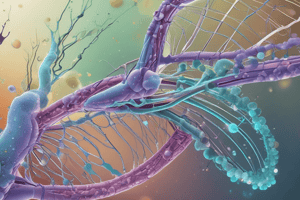Podcast
Questions and Answers
What is meant by constitutive gene expression?
What is meant by constitutive gene expression?
Genes that are always active in cells are constitutive (or house-keeping genes).
How is constitutive gene expression unlike regulated gene expression?
How is constitutive gene expression unlike regulated gene expression?
Regulated gene expression refers to gene expression that is controlled in response to the needs of a cell or organism.
What can you infer about the site of a mutation that causes constitutive expression of a protein that normally shows regulated expression?
What can you infer about the site of a mutation that causes constitutive expression of a protein that normally shows regulated expression?
There is a mutation at the site that normally regulates expression.
Give 2 examples of effector molecules.
Give 2 examples of effector molecules.
How do effector molecules function to regulate gene expression?
How do effector molecules function to regulate gene expression?
What is polycistronic mRNA?
What is polycistronic mRNA?
How does lactose trigger the coordinate induction of the synthesis of β-galactosidase, permease, and transacetylase?
How does lactose trigger the coordinate induction of the synthesis of β-galactosidase, permease, and transacetylase?
What genetic defect(s) might be responsible for an E.coli mutant strain that synthesizes β-galactosidase whether or not the inducer is present?
What genetic defect(s) might be responsible for an E.coli mutant strain that synthesizes β-galactosidase whether or not the inducer is present?
Why are lac Is mutants trans-dominant to the wild-type allele?
Why are lac Is mutants trans-dominant to the wild-type allele?
What are the consequences of mutations in the repressor gene promoter compared to mutations in the structural gene promoter?
What are the consequences of mutations in the repressor gene promoter compared to mutations in the structural gene promoter?
What consequences would a loss-of-function mutation in the CAP gene of E.coli have for the expression of wild-type lac and ara operons?
What consequences would a loss-of-function mutation in the CAP gene of E.coli have for the expression of wild-type lac and ara operons?
Why is catabolite expression considered a form of positive control?
Why is catabolite expression considered a form of positive control?
What are the differences between inducible and repressible operons?
What are the differences between inducible and repressible operons?
Critically evaluate why prokaryotes and eukaryotes use fundamentally different mechanisms to control gene expression.
Critically evaluate why prokaryotes and eukaryotes use fundamentally different mechanisms to control gene expression.
In what different ways can DNA methylation affect gene expression?
In what different ways can DNA methylation affect gene expression?
What are the 3 epigenetic mechanisms that can lead to gene silencing?
What are the 3 epigenetic mechanisms that can lead to gene silencing?
Do you expect gene expression at the 2 genes to be affected in the same way by trinucleotide repeat expansions?
Do you expect gene expression at the 2 genes to be affected in the same way by trinucleotide repeat expansions?
Why might fragile X syndrome be recessive, whereas Huntington disease is dominant?
Why might fragile X syndrome be recessive, whereas Huntington disease is dominant?
What is meant by a DNA clone, and what materials and steps are used to clone genomic DNA?
What is meant by a DNA clone, and what materials and steps are used to clone genomic DNA?
Give 3 examples of methods that rely on complementary base pairing.
Give 3 examples of methods that rely on complementary base pairing.
What purposes do restriction endonucleases serve?
What purposes do restriction endonucleases serve?
Flashcards are hidden until you start studying
Study Notes
Constitutive and Regulated Gene Expression
- Constitutive gene expression involves genes that are always active, known as housekeeping genes.
- Regulated gene expression is responsive to environmental or internal cues, allowing for control over gene activity.
- Mutations causing constitutive expression are likely at sites that normally regulate gene expression, such as operators or repressor genes in bacterial operons.
Effector Molecules
- Tryptophan and allolactose are key effectors that influence the expression of the trp and lac operons, respectively.
- Effectors induce allosteric changes in repressor proteins, modifying their binding affinity to DNA operator sites.
- Allolactose releases the lac repressor, inducing transcription, while tryptophan activates a repressor that inhibits transcription at the trp operon.
Polycistronic mRNA
- Polycistronic mRNA is a single mRNA molecule encoding multiple proteins, produced by active operons.
- This form allows bacteria to coordinate the expression of related genes, optimizing resource allocation and response to environmental changes.
Induction of Enzymes by Lactose
- Lactose presence coordinates the production of β-galactosidase, permease, and transacetylase by initiating the lac operon.
- When glucose is available, its preferred utilization inhibits the lac operon, preventing synthesis of these enzymes.
E. coli Mutant Strain Phenotypes
- An E. coli mutant synthesizing β-galactosidase without an inducer suggests mutations in the operon regulatory elements, such as the operator or repressor genes that disrupt normal regulation.
Lac Is and Mutants
- Lac I^s mutants produce a super-repressor that binds the operator, effectively preventing transcription regardless of lactose presence, exhibiting trans-dominance over wild-type alleles.
- Mutant operons are recessive as they require a functional repressor or operator allele to express β-galactosidase.
Cis-dominant Mutants
- Cis-dominant mutants (e.g., in the promoter region) compete for expression in their vicinity, impacting transcription of adjacent genes while not acting on distant genes.
Repressor Gene vs. Structural Gene Mutations
- Mutations in the repressor gene promoter affect the entire operon, while mutations in the structural gene promoter only impact the expression of that specific gene.
CAP Gene Function in E. coli
- A loss-of-function mutation in the CAP gene would lead to decreased expression of the lac and ara operons due to lack of activation.
- A constitutive mutation would continuously activate these operons, overriding regulatory effects.
Catabolite Expression Control
- Catabolite repression ensures that glucose metabolism takes precedence, often through positive control mechanisms.
- Negative control occurs via the lac repressor, which prevents gene expression in the absence of lactose.
Inducible vs. Repressible Operons
- The lac operon is inducible; it activates in the presence of lactose.
- The trp operon is repressible; its expression is shut down when tryptophan levels are sufficient.
Prokaryotic vs. Eukaryotic Gene Expression
- Prokaryotes utilize simpler mechanisms for gene regulation, while eukaryotic controls are more complex, involving multiple layers, such as chromatin structure and transcription factors.
Transcription Potential with DNA and Proteins
- The order of DNA and protein addition affects the success of transcription; specific combinations can either facilitate or hinder the assembly necessary for transcription initiation.
DNA Methylation Effects
- DNA methylation can silence genes, modify chromatin structure, and prevent transcription factor binding, impacting gene expression patterns.
Epigenetic Gene Silencing Mechanisms
- Key epigenetic mechanisms include DNA methylation, histone modification, and RNA interference.
- All often share the ability to alter gene expression without changing the DNA sequence itself.
Trinucleotide Repeat Expansion Disorders
- Fragile X syndrome is caused by excessive repeats at the 5' end of FMR-1, whereas Huntington disease is linked to repeats within the coding region of the Huntington gene.
- Differences in repeat influences gene expression; fragile X may be recessive due to gene dosage effects, while Huntington is dominant possibly due to toxic gain-of-function from the repeat expansion.
mRNA Regulation Mechanisms
- Different mechanisms regulate mature mRNA production, including alternative splicing and mRNA editing.
- Example: Alternative splicing allows different protein isoforms to be produced from the same pre-mRNA, leading to functional diversity.
Genome Cloning for Sequencing
- DNA cloning involves creating many identical copies of a DNA sequence, utilizing vectors, host cells, and various ligation and transformation steps.
Complementary Base Pairing in DNA Analysis
- Complementary base pairing is crucial in methods like PCR, DNA hybridization, and sequencing, ensuring accuracy in DNA replication and analysis.
Role of Restriction Endonucleases
- Restriction endonucleases serve a defense mechanism in bacteria against viral DNA; they cut DNA at specific sequences, allowing for genetic manipulation and cloning.
Studying That Suits You
Use AI to generate personalized quizzes and flashcards to suit your learning preferences.




